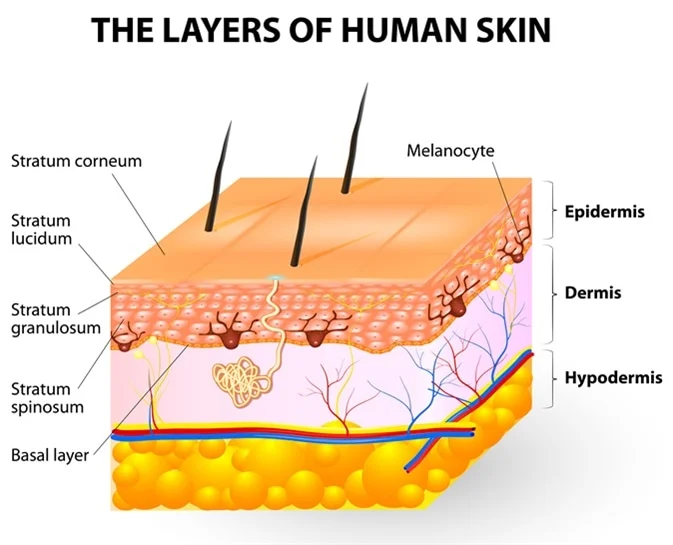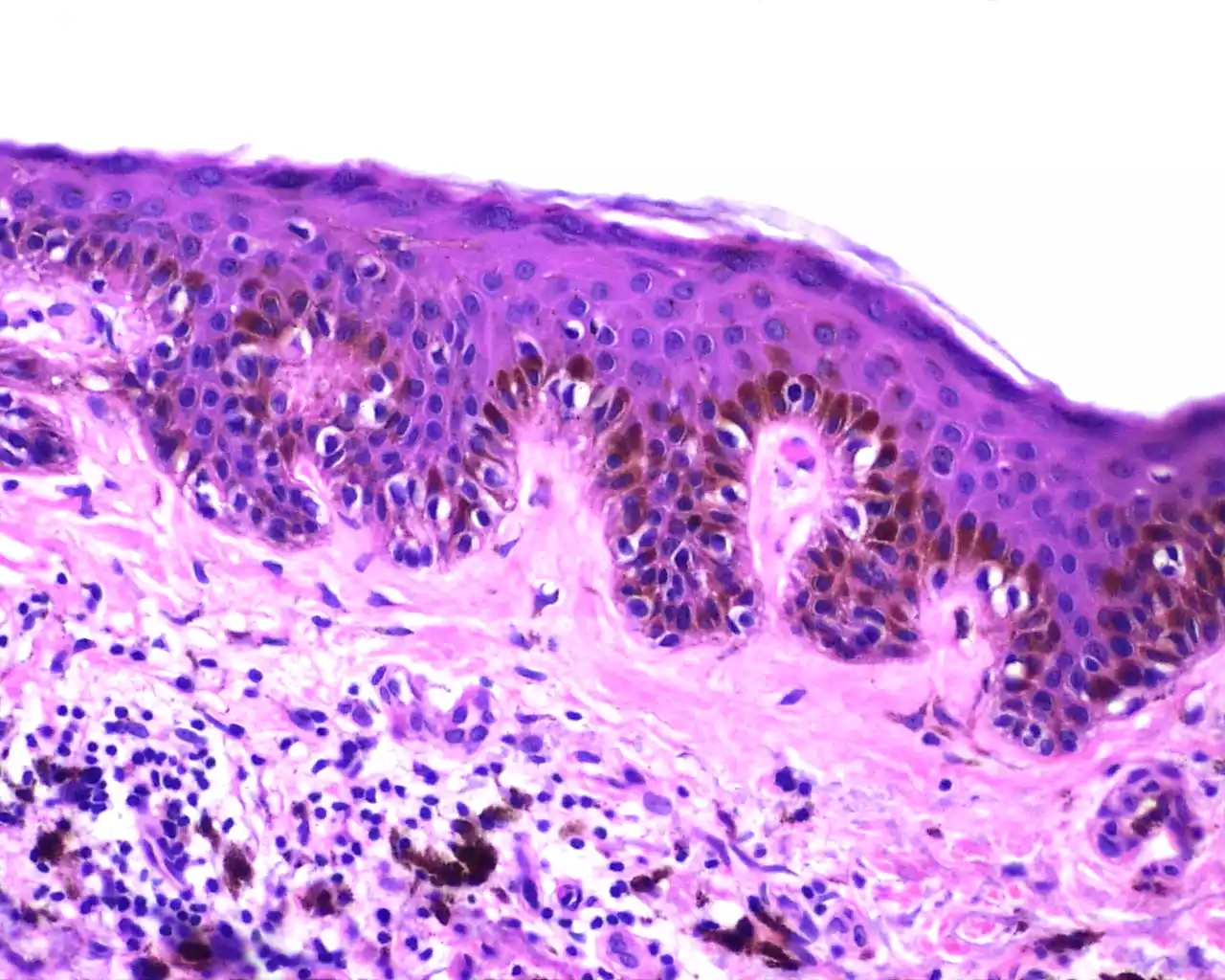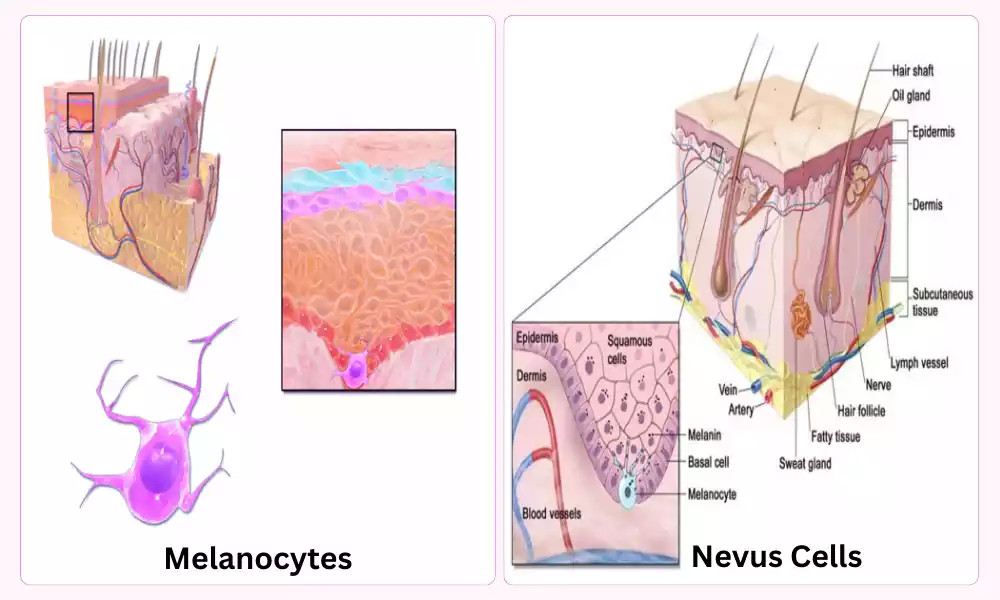Melanocytes, or cells found primarily in the basal layer of the skin, are responsible for the production of melanin. This pigment gives our eyes, skin, and hair color. The mature melanocytes that makeup nevus cells are found within moles and melanocytic lesions.
Melanocytes and Nevus Cells, Both cells have a common lineage but they are different in their characteristics and functions. Understanding these cells can be crucial for skin health and the detection of potential cancers.
Definitions of Melanocytes
Definition: Melanocytes are specialized pigment-producing cells located primarily in the basal layer of the epidermis, the outermost layer of the skin. They also occur in other parts of the body, such as the eye, inner ear, meninges, bones, and heart.
Origin: Derived from neural crest cells during embryonic development, melanocytes migrate to various parts of the body, with a significant concentration found in the skin.

Function: The primary function of melanocytes is to produce and distribute melanin, a pigment that provides color to the skin, hair, and eyes. Melanin production is a response to various factors, most notably ultraviolet (UV) radiation from the sun. Once produced, melanin is packaged into structures called melanosomes, which are then transferred to keratinocytes (the predominant cell type in the epidermis). This process not only gives coloration to the skin but also protects against the harmful effects of UV radiation.
Importance: Melanocytes play a critical role in protecting the skin from UV-induced DNA damage. Additionally, the variation in melanin production across individuals leads to the wide range of skin tones observed in human populations. Dysregulation or mutation of melanocytes can lead to various conditions, including albinism (reduced melanin production) and melanoma (a dangerous form of skin cancer).
Definitions of Nevus Cells
Definition: Nevus Cells are matured, specialized melanocytes that are found in moles and melanocytic lesions. These cells are usually found in clusters or nests. They have evolved from the melanocyte, but they still possess unique characteristics.
Origin: Nevus cell origin is melanocytes.
Service médical à domicile de Medici Generici à Rome
Notre équipe fournit un service de soins de santé à domicile, garantissant professionnalisme et confort pour les patients à Rome.
rewrite-block enable-highlight” data-id=”4″>strong>Origin:/strong> Nevus cells originate from melanocytes.
Location: Nevus cells are found primarily within nevi. Melanocytes are located mainly in the basal epidermis. Depending on the type of mole and its stage, these cells can be found in the epidermis or dermo-epidermal juncture, as well as the dermis.
Morphology: Nevus cells are different from melanocytes in terms of their morphology. They are often rounder and have larger nuclei. As the mole grows, the cells migrate deeper into the dermis and may take on a more spindle shape.

Function: Nevus cells, like melanocytes can produce melanin and contribute to the pigmentation in moles. The melanin produced by nevus cells can vary and cause moles to be of different colors.
Importance: Understanding the nature of nevus cells is important in dermatology. Most moles are benign but some can transform into melanoma. It is important to distinguish between benign nevus and malignant cells for early diagnosis and treatment.
Melanocytes and Nevus cells in the comparison chart
Comparison Chart: Melanocytes vs. Nevus Cells
| Feature | Melanocytes | Nevus Cells |
| Definition | Derived by neural crest cells in embryonic development. | Matured melanocytes are primarily found within moles or melanocytic nevi. |
| Origin | Derived by neural crest cells in embryonic development. | Evolve from melanocytes due to factors like genetic mutations or environmental influences. |
| Location in the Skin | Predominantly in the basal layer of the epidermis. Also found in the eye, inner ear, and other areas. | Mainly within nevi; can be located in the epidermis, dermo-epidermal junction, or dermis depending on mole type. |
| Morphology | Dendritic in shape, allowing them to interact with many keratinocytes. | Often appear rounder, less dendritic. In deeper layers, may become more spindle-shaped. |
| Melanin Production | Produce melanin in response to factors like UV radiation. Packaged in melanosomes for distribution. | Can produce melanin, contributing to the pigmentation of moles. Melanin production may vary between nevus cells. |
| Role in Skin Conditions | Dysregulation or mutations can lead to conditions like albinism or melanoma. | Most are benign, but some can undergo malignant transformation leading to melanoma. |
| Association with UV Radiation | Produces melanin as a shield against UV-induced DNA damage. | Although originating from melanocytes, their primary role isn’t directly associated with UV protection. |
Understanding the differences and similarities between melanocytes and nevus cells is essential, especially in the field of dermatology, where skin health and potential malignancies are of prime concern.
Importance of understanding melanocytes and nevus cells
Understanding Melanocytes & Nevus Cells:
- Skin Health and Pigmentation :
-
- Melanocytes produce melanin, which determines the color of our hair, skin, and eyes. Understanding the function of melanocytes provides insights into human pigmentation, including conditions such as albinism and vitiligo where melanin distribution or production is disrupted.
- Protective UV Radiation:
-
- Melanin is produced by the melanocytes and plays an important role in protecting the skin against harmful UV radiation. Understanding this process will help in developing sun protection methods, and emphasize the importance of adequate protection for people with low melanin levels.
- Skin Diseases:
-
- Different skin conditions can be caused by abnormalities in the structure or function of melanocytes. These conditions may be benign or malignant. Moles are primarily made up of nevus cells. It is important to recognize the normal appearance and behavior of these cells in order to diagnose abnormalities.
- Skin Cancer Treatment and Detection:
-
- Melanoma is a form of dangerous skin cancer that originates in melanocytes. Understanding the normal behavior and characteristics of melanocytes, nevus, and other cells of the skin is crucial for early detection, diagnosis, and treatment of melanoma.
- Aesthetics and Cosmetics:
-
- The knowledge of melanocytes is useful for cosmetic and aesthetic treatments that deal with pigmentation. This includes treatments such as skin-lightening or tanning.
- Genetic Insights and Evolutionary Insights:
-
- Melanocytes provide insights into the evolution of humans. The response of different populations to sunlight exposure has led to variations in melanocyte behavior and melanin.
- Pharmacological Applications and Therapeutic Applications:
-
- Understanding melanocytes can help develop drugs and treatments for skin conditions. It may also lead to better UV protection or the ability to manipulate skin pigmentation.
- For Educational and Awareness Purposes:
-
- By educating the public on the nature of the nevus cell and its function, we can encourage better skin care, the early detection of skin abnormalities, and an appreciation for skin health.
A comprehensive understanding of melanocytes, nevus, and cosmetology cells is fundamental to dermatology, evolutionary biology, oncology, and cosmetics. Their research not only promotes medical advances but also fosters an appreciation for human diversity and skin care.
Common Conditions and Concerns
Common conditions and concerns related to Melanocytes and nevus Cells
- Melanocytic Moles:
-
- Definition: Skin growths that are benign and primarily made up of melanocytes, a type of nevus cell.
- Concerns While the majority are benign, some can change and turn malignant leading to melanoma. It is important to monitor size, shape, and color.
- Melanoma:
-
- Definition: Malignant tumors originating from melanocytes.
- Concerns: A form of skin cancer that is particularly deadly when it is detected late. Early diagnosis and treatment is vital. The risk factors are excessive sun exposure, sunburns in the past, and numerous atypical lesions.
- Vitiligo:
-
- Definition: Loss of pigmentation in patches of skin due to destruction of melanocytes.
- Concerns: Although there is no cure for vitiligo (depigmentation of the skin), treatments can be used to slow down or stop the progress of this condition.
- Albinism:
-
- genetic condition: A genetic condition that causes little or no production of melanin in the hair, skin, and eyes.
- Concerns: Albinism increases the risk of skin cancer and sunburn. Also, they often have vision problems.
- Freckles (Ephelides):
-
- Definition: Brown marks that appear on the face or other areas exposed to sunlight due to an increase in melanin production.
- Concerns: Freckles are not harmful but can indicate sun damage or an increased risk of skin cancer.
- Melasma:
-
- Definition: A condition that causes brown or gray-brown patches to appear on the face. This is often caused by hormonal changes, such as pregnancy, or sun exposure.
- Concerns: cosmetic concerns are the most common. There are many treatment options, including sunscreens, bleaching agents, and laser therapy.
- Postinflammatory Hyperpigmentation
-
- Definition: Darkening after an inflammatory event. This is often seen following acne lesions and other skin injuries.
- Concerns: PIH is distressing, particularly if it is prominent or widespread. Topical treatments may help to speed up the process.
- Blue Nevus
-
- Definition: A benign blue-gray mole, due to its deep location in the dermis.
- Concerns: Concerns are benign but the color can cause it to sometimes be mistaken as melanoma. Dermatological evaluation may be required.
- Nevus Ota and Nevus Ito:
-
- Definition: An increased number of melanocytes within the dermis. Nevus Ota appears on the face and Nevus Ito on the shoulder.
- Concerns: Most cosmetic, although there is a slight risk of developing melanoma, particularly in the eye of Nevus of Ota.
Understanding the conditions and potential risks of these skin disorders is important for proper care and early detection. It also helps to seek medical attention when necessary. Self-examinations and regular dermatological checks are advised, particularly for people with a history of multiple moles.
Conclusion
Skin health depends on understanding the differences and roles of melanocytes and cells. While these cells are derived from the same source, they function differently and have different skin conditions.
Early detection, more effective treatment, and better prevention are possible when you recognize their behavior and conditions. Skin anomalies and regular skin checks are crucial for maintaining skin health.

